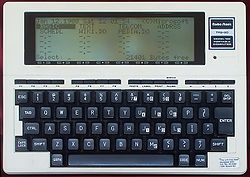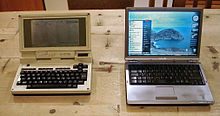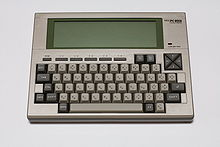- TRS-80 Model 100
-
TRS-80 Model 100 
Developer Kyocera, Tandy, Microsoft Release date 1983 Introductory price USD$1099 for 8K version
USD$1399 for 24K versionsUnits sold 6,000,000 Operating system Custom dedicated runtime in firmware CPU Intel 80C85 @ 2.4 MHz Memory 8 KB - 32 KB (supported) Display 8 lines, 40 characters LCD Graphics 240 by 64 pixel addressable graphics Input Keyboard:56 keys, 8 programmable function keys, and 4 dedicated command keys Dimensions 300 by 215 x 50 mm Weight About 1.4 kilograms (3.1 lb) with batteries The TRS-80 Model 100 was an early portable computer introduced in 1983. It was one of the first notebook-style computers, featuring a keyboard and liquid crystal display, battery powered, in a package roughly the size and shape of notepad or large book.
It was made by Kyocera, and originally sold in Japan as the Kyotronic 85. Although a slow seller for Kyocera, the rights to the machine were purchased by Tandy Corporation, and the computer was sold through Radio Shack stores in the United States and Canada as well as affiliated dealers in other countries, becoming one of the company's most popular models, with over 6,000,000 units sold worldwide. The Olivetti M-10 and the NEC PC-8201 and PC-8300 were also built on the same Kyocera platform, with some design and hardware differences. It was originally marketed as a Micro Executive Work Station (MEWS), although the term did not catch on and was eventually dropped.
Contents
Specifications
- Processor: 8-bit Intel 80C85, CMOS, 2.4 MHz
- Memory: 32 kB ROM, 8, 16, 24, or 32kB static RAM. Machines with less than 32 kB could be expanded in 8 kB increments of plug-in static RAM modules.
- Display: 8 lines, 40 characters LCD with 240 by 64 pixel addressable graphics. The screen was not backlit.
- Keyboard: 56 keys, 8 programmable function keys, and 4 dedicated command keys.
- Peripherals: The basic package included: Built-in 300 baud modem (North American versions), parallel printer port, serial communication port (shared by internal modem), bar-code reader input, cassette audio tape, real-time clock.
- Dimensions: 300 by 215 x 50 mm, weight about 1.4 kilograms (3.1 lb) with batteries
Power supply: Four penlight (AA) cells, or external power adapter 6V (>180 mA, tip negative configuration)
The 8K and 24K versions sold for USD$1099 and USD$1399 respectively.[1]
The Model 100 was promoted as being able to run up to 20 hours and maintain memory up to 30 days on a set of four alkaline AA batteries.
The Tandy Portable Disk Drive (TPDD), a serial device capable of storing 100 KB of data on a 3.5 inch diskette was also available. A second version, the TPDD2, could store up to 200 KB, as it used double sided disks.
A disk-video interface expansion box was released in 1984, with 5-1/4 inch disk drives and a CRT video adapter. This allowed the Model 100 to display 40 or 80 column video on an external television set or video monitor.
A bar code reader wand was also offered.
ROM firmware
When first switched on, the Model 100 displays a menu of applications and files and the date and time. The ROM firmware based system boots instantly, which compares very favourably to disk-based computers. Not only is the machine ready to use immediately on power-up, but it will also continue running, from the same point, the program that was running when the unit was powered off. Cursor keys are used to navigate the menu and select one of the internal or added application programs, or any data file to be worked upon.
The 32 kilobyte read-only memory of the Model 100 contains the N82 version of the Microsoft BASIC 80 programming language. This is similar to other Microsoft BASICs of the time and includes good support for the hardware features of the machine: pixel addressing of the display, support for the internal modem and serial port, monophonic sound, access to tape files, and support for the real-time clock and the bar code reader. Unlike other Microsoft BASIC interpreters of the time, the default for floating point numbers is double-precision.
The ROM also contains a terminal program, TELCOM; an address/phone book organizer, ADDRSS; a to-do list organizer, SCHEDL; and a simple text editor, TEXT. The TELCOM program allows automation of a login sequence to a remote system under control of the BASIC interpreter.
As with other home computers of the era, a vast collection of PEEK and POKE locations were collected by avid hobbyists.
Invisible files in the system RAM named "Hayashi" and "Suzuki" commemorate the names of designers Junji Hayashi and Jay Suzuki. Another invisible deleted file named "RickY" refers to Rick Yamashita.[2] The Model 100 firmware was the last Microsoft product that Bill Gates developed personally, along with Suzuki. According to Gates, "part of my nostalgia about this machine is this was the last machine where I wrote a very high percentage of the code in the product".[3]
Added applications and data files are stored in the internal battery-backed RAM; these can be loaded from and stored to an audio cassette tape recorder or external floppy disk drive. Optional ROMs can be installed in the Model 100, providing a range of customized application software.
The Model 100 ROM has a Y2K bug; the century displayed on the main menu was hard-coded as "19XX". Workarounds exist for this problem.
Applications
When introduced, the portability and simplicity of the Model 100 made it attractive to journalists,[4] who could type about 11 pages of text and then transmit it using the built-in modem and TELCOM program for electronic editing and production. The computer is silent when it operates. The keyboard is full-size and uses a standard (QWERTY) layout. It runs for 20 hours on 4 readily available and easily replaceable AA batteries. Data is protected by a built-in rechargeable battery. There is no boot up routine; the Model 100 operates as soon as the switch is flipped and an application selected. There are several simple programs available on the Internet for transferring Model 100 files to a modern personal computer.
The Model 100 was also used in industrial applications as a programming terminal for configuration of control systems and instruments.
Third-party peripherals for the Model 100 extended its battery life and file storage capacity. Software was designed, and is still available, to extend the display capabilities and to provide more advanced word-processing or calculation software than the supplied programs. To this day, hobbyists continue to design games, applications, and hardware for this device.
Modern portable computers (laptops) are larger, heavier, and have much shorter battery life than the Model 100. The closest modern successors include the Alphasmart Dana and the Quickpad Pro. These similar modern "slabtop" units typically are targeted at the education market, although they are often used by writers and mobile professionals.
Although much larger, the Model 100 actually bears a close resemblance to modern PDAs. Its TEXT program is similar to the Memo program found on PalmOne products, and ADDRSS and SCHEDL are essentially simplified versions of Contacts, Tasks and Calendar. The Model 100 has the additional advantage of a full size keyboard, a built-in modem and BASIC programming language. By including BASIC, the Model 100's designers made it possible for users to design additional applications.
Because of its adaptability and features as well as its current relative affordability, the Model 100 and its progeny (Model 102/200/600) enjoy a near cult status among its supporters. Club 100 and Bitchin100 are the center of the Model 100 universe. Model 100 enthusiasts continue to explore this early computer, trading information, participating in contests and designing new applications with existing and newly designed hardware and software.
Peers and successors
The Tandy 200 was introduced in 1984 as a more capable sister product of the Model 100. The Tandy 200 had a flip-up 16 line by 40 column display, and came with 24 KB RAM which could be expanded to 72 KB (3 banks of 24 KB). It included Multiplan, a spreadsheet application. It also added DTMF tone dialing for the internal modem, where the Model 100 only supported pulse dialing.
The last new model that could be considered part of this line was the Tandy 600, introduced in October 1985. Similar to the Tandy 200, it featured a flip-up screen, but with 80 columns rather than 40. Built-in features included a 3.5" diskette drive, rechargeable batteries, and 32K of RAM expandable to 224K. The underlying software platform was Microsoft's 16-bit Hand Held Operating System (Handheld DOS or HHDOS), along with word processing, calendar, database, communication and spreadsheet software. Unlike earlier models, BASIC was an extra-cost option rather than built in.[5]
The last refresh to the product line was the Tandy 102, introduced in 1986 as a direct replacement for the Model 100, having the same software, keyboard and screen, and a nearly identical, but thinner, form factor. Minimum memory was 24 KB RAM.
Later portables from Tandy no longer featured a ROM-based software environment, starting with the Tandy LT1400, which ran a diskette-based MS-DOS operating system.
Similar computers from other companies
As mentioned previously, the Olivetti M-10 and the NEC PC-8201 and PC-8300 were also built on the same platform as the original Kyocera design. The earlier and smaller Epson HX-20 of 1983 used a much smaller LCD display, four lines of twenty characters, and had an internal cassette tape drive for program and file storage. There were several other "calculator-style" laptops available at the time, including the Casio FP-200, the Texas Instruments CC-40, and the Canon X-07.[6]
Systems of about the same size and form-factor as the Model 100, aimed at journalists, were sold by companies such as Teleram, as the Teleram T-3000[7] and GRiD Systems, as the GRiD Compass, which was used by NASA. GRiD was later acquired by Tandy. The Bondwell 2 of 1985 was a CP/M laptop in a similar form factor to the Model 200.
Data General developed the Data General-One (DG-1), a much more powerful (but more costly) MS-DOS portable computer with disk drives and a full-sized LCD screen, similar to the Tandy LT1400. It was released in 1984. The Zenith ZP-150, also of 1984, was introduced prior to the Tandy 600. The two computers were notably similar, although the ZP-150 did include BASIC and could be configured with more memory, but did not have a built-in diskette drive.
The Cambridge Z88 of 1987, developed by British inventor Sir Clive Sinclair, was similar in form and functionality to the Model 100 but had greater expansion capacity.
Emulator
- VirtualT An open source Model 100/102/200 emulator with an integrated debugger, hardware access utilities and a complete FX-80 printer emulation.
Aftermarket products
- DLPilot - allows a PalmOS PDA with a serial port to emulate a Tandy TPDD drive, providing affordable, compact, and portable storage that is easily synced to a desktop computer
- ReMem - replaces all the memory in the laptop, allowing the use of 4MB of flash ROM and 2MB of SRAM
- REX - memory subsystem that fits in the option ROM socket
- Tandy 200 RAM Module - adds 2 banks of 24kb to a T200
- NADSBox - New Age Digital Storage Box - Interfaces an SD media card using the Tandy TPDD drive protocol for portable storage and easy file transfers to a desktop computer using industry standard FAT formatted Secure Digital cards.
- PCSG's SupeROM - WriteROM word processor; FORM spreadsheet input template; LUCID spreadsheet; Database (relational); Thought outliner.
References
- ^ "The Micro Executive Workstation(TM)". Radio Shack 1984 Catalog. Tandy Corporation. 1984. pp. 59. http://www.classiccmp.org/dunfield/kyocera/h/m100ca84.jpg. Retrieved 2008-01-08.
- ^ Akira Kogawa (October 28, 2005). "The Bill Gates I Know, Volume 12" (in Japanese). http://furukawablog.spaces.live.com/Blog/cns!1pmWgsL289nm7Shn7cS0jHzA!2149.entry. Retrieved 2008-01-08. Title and author obtained via Google translation from the original Japanese.
- ^ Gates, Bill. Interview with Bill Gates. with David Allison. Transcript of a Video History Interview by the National Museum of American History, Smithsonian Institution. http://americanhistory.si.edu/collections/comphist/gates.htm#tc35. Retrieved 2008-01-08.
- ^ Bruce Garrison Computer-assisted reporting, Routledge, 1998 ISBN 0805830219 , page 192
- ^ "The Tandy 600 FAQ - Version 3". DigitalDinos. May 26, 2008. http://www.digitaldinos.com/DigitalDinos/Pages/Information/docT600FAQ30.html. Retrieved 2009-02-22.
- ^ 14 notebook computers in brief: Creative Computing Vol 10 No 1, January 1984
- ^ The Portable Companion, June/July 1982
- Notes
- TRS-80 Model 100 Owner's Manual, (1983) Tandy Corporation, Fort Worth Texas
- BYTE Magazine April 1984, advertisement for Disk-Video Interface
- BYTE Magazine May 1985, advertisement for Model 200
- Rich Malloy, "Little Big Computer: The TRS 80 Model 100 Portable Computer", BYTE magazine, May 1983 pg. 14
- Stan Wszola, "NEC PC 8201 Portable Computer", BYTE magazine June 1983, pg. 282
External links
- RadioShack Computer Catalogs (view ALL of them)
- Club 100
- Bitchin100
- Model T DocGarden
- Web 8201
- a photograph of the TRS-80 Model 100 and closely related machines
- Tandy TRS-80 Model 100 Teardown
Categories:- NEC personal computers
- Portable computers
- 1983 introductions
Wikimedia Foundation. 2010.



